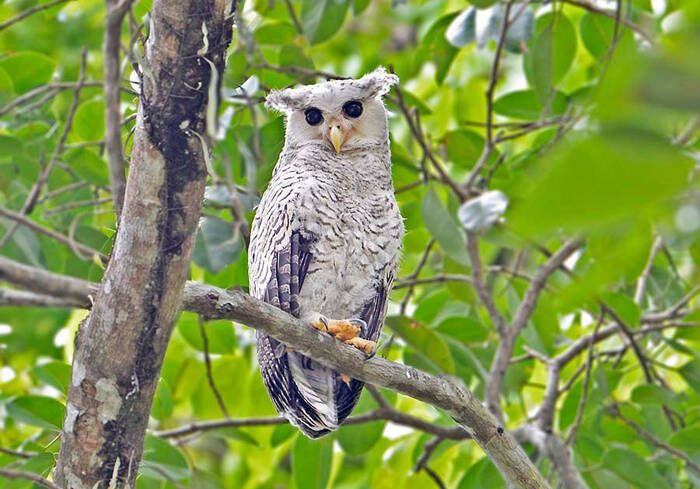Bubo nipalensis
IUCN
LCBasic Information
Scientific classification
- name:Bubo nipalensis
- Scientific Name:Bubo nipalensis,Spot-bellied Eagle-owl
- Outline:Raptor
- Family:Strigiformes E.Owl
Vital signs
- length:About 63 cm
- Weight:1-2.5kg
- lifetime:About 10-20 years
Feature
Similar in appearance to an eagle owl, but smaller in size
Distribution and Habitat
It is distributed in India, Nepal, Sikkim, Bhutan, Sri Lanka, Myanmar, Thailand, Laos and Vietnam.
It is only found in Ya'an, Baoxing, Huidong, Sichuan and the estuary of southeastern Yunnan in China.
It lives in evergreen broad-leaved forests below 3,000 meters above sea level.
Appearance
The eyes and cheeks are covered with brown-white whisker-like feathers, and the feather stems are black. There are also brown-white whisker-like feathers on the chin, but the rachis is white. The ear feathers are prominent. The inner ring is mostly brown and white with dark brown horizontal spots; the outer ring is dark brown with brown and black horizontal spots; the face plate is pale white. The upper body, including the inner side of the shoulders and the upper wing coverts, is dark brown, with yellow-white spots and horizontal spots on the skin. Brown horizontal spots are faintly visible on the top of the head. The small coverts on the back and wings are mixed with brown horizontal spots and terminal spots. The outer shoulder feathers are brown or yellow with dark brown horizontal spots; the primary flight feathers are dark brown with light brown horizontal spots and feather edges. The secondary flight feathers have wider transverse spots and are mostly yellow-brown. The innermost
Details
Spot-bellied Eagle-owl, also known as Spot-bellied Eagle-owl, is a large owl with no subspecies.

The eagle owl mainly feeds on small and medium-sized vertebrates such as pheasants, hares, rodents, lizards, and snakes. It can also hunt larger animals such as peacocks, jackals, and young deer, and even fish.
The eagle owl is mostly solitary. It is nocturnal and usually hides in dense branches and leaves during the day, and only starts to move and forage at dusk. When it is particularly hungry, it sometimes comes out to hunt during the day. When hunting, it often moves along the open areas at the edge of the forest, the sparse forests at the edge of the forest, the bamboo groves or near the river bank.
There are no reports on the reproduction of the eagle owl in China. The breeding season of the eagle owl in the Himalayas is between February and March, and it may breed two nests a year. Because he found another egg that was about to hatch on June 20, he thought it might be the second nest of eggs laid after the first nest was hatched. It usually nests in natural tree holes or cracks on cliffs, and sometimes uses old eagle nests. Each nest usually lays one egg, which is oval, white, smooth and spotless, and measures 61.2 mm x 49.9 mm.
China's national key protected animal level: Level 2.
Listed in the CITES II level protected animal of the Washington Convention.
Listed in the 2012 Red List of Endangered Species of the World Conservation Union (IUCN) ver 3.1 - Least Concern (LC).
Listed in the Level 2 of the List of Wild Animals under National Key Protection in China.
Protect wild animals and stop eating game.
Maintaining ecological balance is everyone's responsibility!








